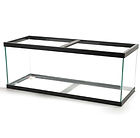
Sustainable at Home Farming
Home Aquaponics
Issues with Modern Farming


What is Soil Depletion?
Nutrients and other components that contribute to the vitality and fertility of soil are taken away and not replaced.
The average annual rate of soil erosion in the country is
5334 million tons per year.
What is Water Waste?
On average, farms around the world account for 70% of all water that is consumed annually.
Of that 70% used by farmers, 40% is lost to the environment due to poor irrigation systems, evaporation, and overall poor water management.
What do they mean?
Unfortunately, the nature of modern farming practice is that the quality of vitamins and minerals in the soil have been gradually degraded over hundreds of years, meaning that less and less of these vital micro-nutrients are making their way into the food we eat. In fact,
to get the same amount of vitamin A from an orange as our grandparents would have done, we would need to eat eight oranges today.
As the world continues to increase in population, demand for food and water will continue to rise.
By understanding how our water is
currently utilized in agriculture, we can continue to learn and discover new methods of farming to maximize production as well as conserve our water supply.
Areas for Improvement

diagram provided by *http://www.food.systems/
Non-domestic farms use unhealthy practices that can lead to bad or contaminated food.
1. Production
Trucks, planes and boats transmit high amounts of carbon emissions from transporting food.
2. Transportation
3. Processing
Introduces preservatives making food less fresh and filled with nitrates.
Shelf life is short and leads to a large waste issue.
4. Retail
What are ways to bring fresh and nutritious food to consumers in a way that conserves the water supply?
What is Aquaponics?
*Images taken of *https://roothouseaqua.com/

Uses less water than conventional farming.
Water Conservation

Grow without soil and avoid the issue of soil erosion.
Soil Free

Removes the need for chemical pesticides and fertilizers.
No Chemicals
Research



Aquaponic farm with sustainable and responsible practices with year round production
1. Visiting Local Aquaponics
Imitating an environmental system to the best of one’s ability.
Biomimicry
The media bed form of aquaponics uses containers filled with rock media such as gravel or expanded clay (hydroton) to support the roots of plants. The bed is flooded and drained of nutrient rich water to give the plants the nutrients and oxygen they need.
Media Bed must:
1. Located above the aquarium
2. Allow access to the fish and greens
3. Allow waterflow in and out
Media Bed Aquaponics



Step-by-step instructional on how to build a functional aquaponics unit.
2. Self Assigned Readings

*Diagram taken from Beginner's Guide to Aquaponics
User Experience
Automatic Fish Feeder
This fish feeder after one charge for 5
hours can function for up to 8 months.
Proper Exposure to Light
You can either use artificial lighting to
encourage plant growth or install your
unit in an area that gets exposure to
sunlight.
Biofilter
This prevents hard excrement from clogging the Bell Siphon. Must be cleaned out every two weeks.
1. Greens can be harvested
when reached desired size.
2. Lettuce
30 days
3. Tilapia fish reach plate size after about
7-9 months

Automatic Fish Feeder

55-Gallon Tank

Water Pump

Transparent Acrylic

Air Pump

PVC Pipe

Basil

Lavender


Mint
Rosemary

Bio Beads

Pitcher

Tilapia
Factors Considered and Explored

Temperature
The produce of this project were decided based on the temperature best fit for average room temp at 76 °
Space
Fish grow to their largest when living in spacious conditions which is why I chose a 55-gallon tank.
Tilapia Growth Rate
Each fish grows to largest size within 6-8 months.
This is an indoor product to prevent exposure to seasonal temperature changes.
Construction



*Not pictured: construction of the bell siphon, construction of the biofilter, washing the clay pebbles, integrating plants and fish
Final Design


This media bed form of aquaponics uses containers filled with rock media such as gravel or expanded clay (hydroton) to support the roots of plants. The bed is flooded and drained of nutrient rich water to give the plants the nutrients and oxygen they need.
Media Bed Aquaponic Tank